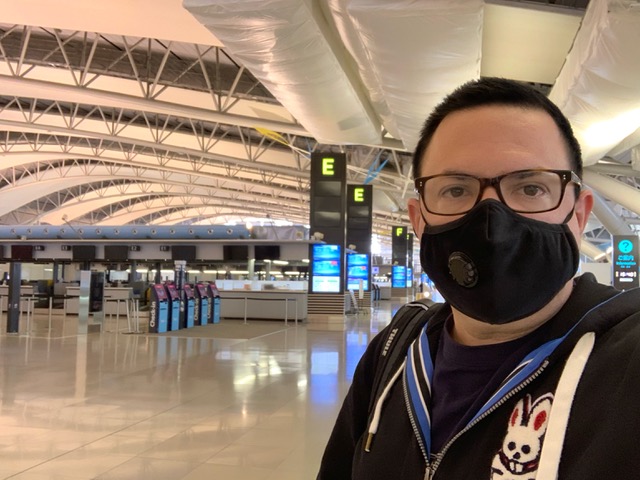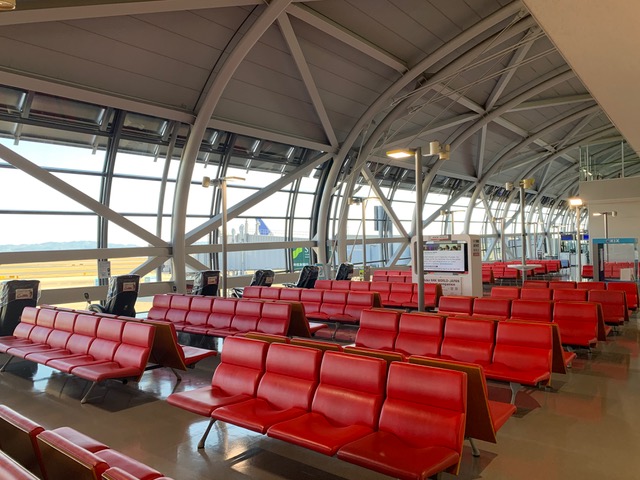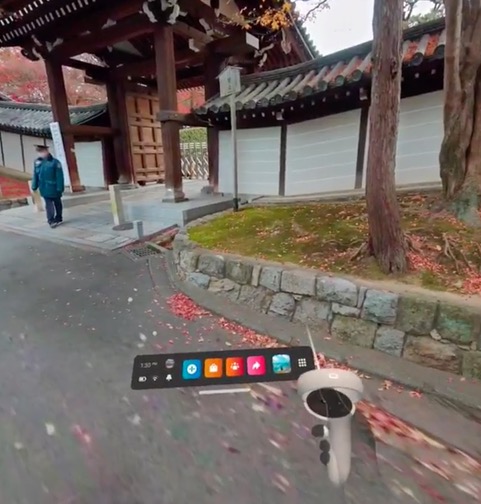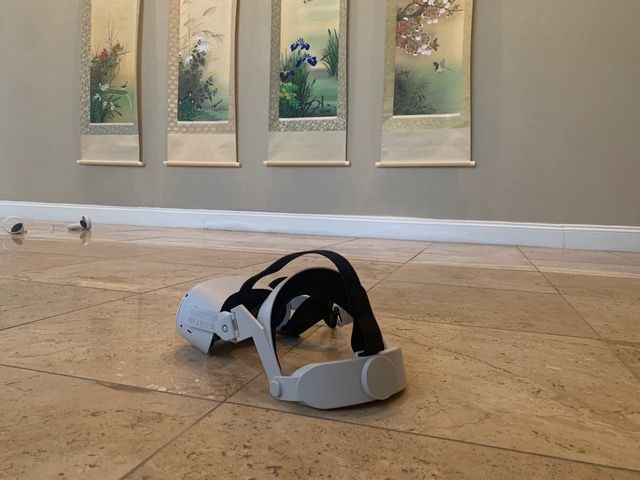by Fernando Torres

I have become a yūrei, my disembodied form drifting through the streets and back alleys of Kyoto — unseen — unnoticed. There on my left is my neighbor, frozen in time, her nose almost touching the ground from decades of "floor culture" and bones that stretch back to the Taishō era. "Ohayō gozaimasu!" I shout, but her broom doesn't move. There is no point to my aisatsu; I have become a fuyūrei, a wandering spirit. My neck pivots to the sky to gaze at birds who are still like flowers, preserved between pieces of wax paper. My neighborhood is surprisingly unchanged; our trash is even under the same blue net that prevents the large-billed crows from carrying it away. Walking further, I reach where our street narrows, as they often do in Kyoto, and I am unable to continue. I can see the top of my house, but no matter how much I strain, I am frozen but ten meters from my door. Is this Purgatory? No matter how much I yearn for my front gate, there is an invisible wall. My virtual reality headset comes off, and the 360-degree image collapses. Back in America, I experience momentary disorientation, or perhaps it is melancholy. No matter how complete the app's database, it lacks the final images to allow me to return home.
My transformation into a ghost begins at Kansai airport, which greets me as an apocalyptic wasteland, like something from a dystopian novel. My friends in Asia have urged me not to leave Japan. America is at the height of the pandemic, but life in Japan is only starting to become constrained. "You have a house in Kyoto. There is no reason for you to leave." But I know differently.
My last days in Kyoto are pleasant. People elsewhere in the world are in total lockdown, yet I enjoy strolls in Shosei-en Garden and buying the washi for the poetry lantern I'm creating. Aware of the shortages that hit America, I am one of the few prepared when the shelves start to empty. Hoping to get just a couple of small items, I stop by the large market at Katsuragawa, but everything is already gone. I have one final lunch with my neighbors where we exchange gifts of masks and toilet paper. That night, sitting by the Kamo river, the future is uncertain, but little do I realize how long it will be before I see Kyoto again. The next time I return, my physical form will not accompany me.
As I walk towards customs, I am a condemned man voluntarily pursuing their executioner. The airport shops are barren, their boxes of omiyage undisturbed. Thousands of empty chairs pass by, with not one weary traveler to fill them. I start to wonder if this is even real, or perhaps I am the one whose reality is deceived. Does this scene not resemble that of ghostlore, where spirits are forced to wander the places they once knew, ignorant of their circumstances? What else could explain how my backpack has no companion as it passes through the x-ray machine? I linger, but no one joins me. Where is the grumpy ojisan I usually encounter, the one annoyed at how long it takes for me to gather my things? Where is the multitude of other voices who drown out the announcements to which we pay no mind? I continue downstairs to customs, a vast area designed to process thousands of international travelers, but I am alone. Only those who work there remain, their eyes fixed upon me at once. They all look as if they have seen a ghost.
A few months later, back in America, I am in the emergency room, the ER ward's first VR-related incident. My finger is askew, and it appears like I won't be playing the piano any time soon. My misfortune is the result of a virtual ping pong game. The app's real-world physics are so close to reality that I subconsciously forget that the table doesn't exist and as I lunge for the ball, my finger jams into the wall. When I throw off my headset, it is discovered to be at a most bizarre angle—I am rushed to the emergency room. Only one doctor is available, as it is the weekend. With another patient in the midst of a heart attack, I clutch my hand and wait. When the doctor finally arrives to pull it back into place, I experience the kind of pain reserved for heretics and prisoners of the crown. Apparently, there really are a lot of nerves in your hands. When the x-ray technician returns, both he and the doctor are astonished; nothing is broken. But I know the reason. I have become a ghost, and y(u)rei are not susceptible to the injuries of men. My accident does not deter me; within twenty-four hours, I am back in the metaverse.
My first encounter with virtual reality was at the Aichi Expo in 2005. Hitachi had an exhibit that demonstrated AR, or mixed reality. Visitors to the unfortunately named "Ubiquitous Entertainment Ride" could interact with endangered species via a hand-held display that superimposed digital 3D graphics over moving dioramas. A hand sensor allowed you to feed digital monkeys bananas or play with a sea turtle. It was an astonishing display of a technology that is only now becoming available to the general public. I had written about virtual and augmented reality in the early 1990s, but that material never saw publication. However, I revisited many of those themes in my recent novel, "More Than Alive: Death of an Idol," a sci-fi novel set in a near-future Tokyo and Kyoto. It retained the same premise that the yakuza had developed a drug that numbed suspension of disbelief, making VR seem real—but with a supernatural twist.
The story's ghost angle, however, came from a rather disturbing incident at Inari shrine. Wanting to impress a visiting friend, I waited until nightfall to show him how beautiful the shrine could be without tourists from Kansas taking selfies. An hour later, though, it almost appeared my friend was going to need counseling as he kept murmuring about the ghostly cat lady he kept seeing in random locations and the dark void he feared would swallow us. I'll admit I was a little surprised when I later learned that there had been many disappearances in that particular area at night, but I was more concerned about the sound of snorting wild boars in the shadows. Our neighborhood actually made the local news when some of those demon hogs came down from the hills and attacked a couple of people. There was blood smeared all over a metal door not far from my house. Still, I had only had a problem with ghosts the first night I moved into my 120 year-old-house, but that was most certainly a fluke.
For centuries, artists have attempted to illustrate the wandering spirits of Kyoto. For all practical purposes, I have become one of them; my mortal coil peeled away by technology and not death. I imagine my ethereal form illustrated upon a hanging scroll with a VR headset, something not often found in a kakejiku.
Actually, a couple of my Kyoto neighbors have become aware of my plight through our message group on Line. They have seen the recorded footage of my virtual journey and how I am trapped at the point where our street narrows. What happens next is quite unconventional, though. My next-door neighbor, Kaori, has decided that she is not willing to accept the familiar mantra that "it can't be helped." Perhaps she has sensed my immaterial form at the end of the street, fixed in place by the policies of nation-states and the limitations of technology. Stepping into the sweltering Kyoto sun, she raises her phone and snaps several pictures. The database is complete, and as she clicks "send," I find myself immediately released. My spirit surges forward, and I complete the final leg of my journey, arriving beside my inuyarai gate. My hyosatsu greets me, and for once, I no longer feel like a stranger. For at that moment — if only within a waking dream — I am home.










Recent Comments